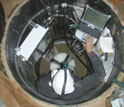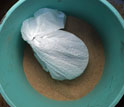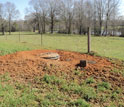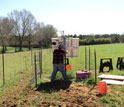News Release 11-065
EarthScope Seismic Sensors Head East of the Mississippi
First such station installed northwest of Columbia, Mississippi
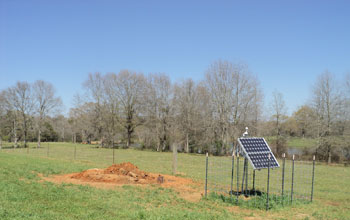
EarthScope Transportable Array Station 345A is about 15 miles northwest of Columbia, Miss.
March 31, 2011
This material is available primarily for archival purposes. Telephone numbers or other contact information may be out of date; please see current contact information at media contacts.
Most seismic activity--and earthquakes--have been in the U.S. West. But the East is not out of the woods in terms of risk, geologists say.
After a six-year march eastward from the U.S. West Coast, the EarthScope Transportable Array seismic network has reached a major milestone: installation of the first Transportable Array station east of the Mississippi River.
Station 345A, located on a private farm about 15 miles northwest of Columbia, Miss., will operate for the next two years, continuously recording ground motion from local, regional and global earthquakes.
The Transportable Array is part of the National Science Foundation (NSF)-funded EarthScope project, an integrated Earth science effort to explore the structure, evolution and dynamics of the North American continent.
EarthScope has additional support from NASA and the U.S. Geological Survey. The Transportable Array is constructed, operated and maintained by the Incorporated Research Institutions for Seismology (IRIS) as part of EarthScope.
"Research using data from the Transportable Array has already improved our understanding of the structure and dynamics of the western United States," says Greg Anderson, NSF program director for EarthScope.
"With the arrival of the Transportable Array in the eastern United States," Anderson says, "scientists will derive new insights about the older core of our continent and processes related to the formation and modification of continents over geologic time."
Because the Western part of the country regularly experiences earthquakes that can be felt, "the region has dozens of permanent seismometers to observe fault movements," says Bob Woodward, director of the USArray, the seismic component of EarthScope.
"Seismic stations east of the Mississippi River are much less common."
The Transportable Array network comprises a grid of 400 state-of-the-art seismic stations installed about 70 kilometers apart.
Each station is a stand-alone system with a seismometer and electronic equipment installed about six feet below ground and solar panel and communications equipment at the surface.
Most Transportable Array stations, like 345A, have been installed on private land; the landowners serve as volunteer hosts and are enthusiastic about advancing knowledge of Earth's inner workings.
To date, Transportable Array stations have been installed in more than 1,100 locations, out of an expected 1,600 by the end of the first ten years of EarthScope in 2013.
These stations have recorded over 22 terabytes of data that are freely available to Earth scientists, educators and the public across the U.S. and around the world.
-NSF-
-
An engineer tests the station after the electronics are installed. The seismometer is in the center.
Credit and Larger Version -
The seismometer is wrapped in plastic to keep it clean and dry, and placed in sand for stability.
Credit and Larger Version -
A vault containing the seismometer and electronics is tightly sealed before covering with dirt.
Credit and Larger Version -
Transportable Array stations are generally installed on private property; owners look in the vault.
Credit and Larger Version -
A solar panel is installed some 20 feet from the vault. A battery in the vault is solar-powered.
Credit and Larger Version
Media Contacts
Cheryl Dybas, NSF, (703) 292-7734, email: cdybas@nsf.gov
Related Websites
EarthScope Project: http://www.earthscope.org
The U.S. National Science Foundation propels the nation forward by advancing fundamental research in all fields of science and engineering. NSF supports research and people by providing facilities, instruments and funding to support their ingenuity and sustain the U.S. as a global leader in research and innovation. With a fiscal year 2023 budget of $9.5 billion, NSF funds reach all 50 states through grants to nearly 2,000 colleges, universities and institutions. Each year, NSF receives more than 40,000 competitive proposals and makes about 11,000 new awards. Those awards include support for cooperative research with industry, Arctic and Antarctic research and operations, and U.S. participation in international scientific efforts.
Connect with us online
NSF website: nsf.gov
NSF News: nsf.gov/news
For News Media: nsf.gov/news/newsroom
Statistics: nsf.gov/statistics/
Awards database: nsf.gov/awardsearch/
Follow us on social
Twitter: twitter.com/NSF
Facebook: facebook.com/US.NSF
Instagram: instagram.com/nsfgov



